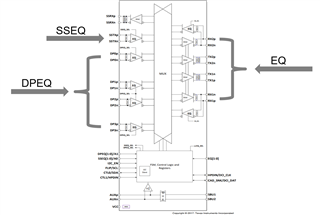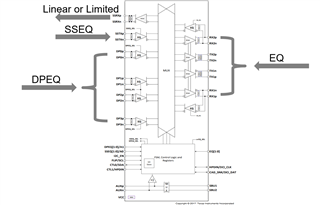Other Parts Discussed in Thread: TUSB546A-DCI, TUSB1046-DCI, TUSB1046A-DCI, TUSB1146
Tool/software:
TUSB546-DCI has three sets of equalization (EQ), what is the difference among DPEQ, EQ, and SSEQ?
This thread has been locked.
If you have a related question, please click the "Ask a related question" button in the top right corner. The newly created question will be automatically linked to this question.
Tool/software:
TUSB546-DCI has three sets of equalization (EQ), what is the difference among DPEQ, EQ, and SSEQ?
TUSB546-DCI, TUSB546A-DCI, TUSB1046-DCI, TUSB1046A-DCI, and TUSB1146 are VESA USB Type-C Alt Mode redriving switch supporting data rates up to 10 Gbps for downstream facing port (DFP). The re-driver provides several levels of receive equalization to compensate for cable and board trace loss due to inter-symbol interference (ISI) when USB 3.1 Gen1/Gen2 or DisplayPort 1.4/2.0 signals travel across a PCB or cable. The re-driver has independent equalization control for each channel. Below block diagram shows the equalization control.

In GPIO or pin-strap mode, equalization can be set using EQ[1:0], SSEQ[1:0], and DPEQ[1:0] pins. Please note the same equalization is applied to all four DisplayPort (DP) lanes and RX1 and RX2. In the I2C mode, individual equalization can be applied to each DP lane and RX1/2.
For SSRX, TUSB546-DCI, TUSB546A-DCI, TUSB1046-DCI, and TUSB1046A-DCI SSRX is linear only. For TUSB1146, it can support both linear or limited mode. In the limited mode, the TUSB1146 TX can provide additional compensation to the corresponding RX.

Thanks
David
Thanks
David